Dynamic Analysis of Urban Land Use Efficiency in the Western Taiwan Strait Economic Zone
Abstract
:1. Introduction
2. Data and Methodology
2.1. Study Area
2.2. Indicator Selection and Data Source
2.2.1. Input Index
2.2.2. Output Index
2.3. Methodology
2.3.1. Super-Efficiency EBM Model
2.3.2. Malmquist–Luenberger Index
2.3.3. Kernel Density Estimation
3. Results
3.1. Results of Urban Land Use Efficiency
3.1.1. Results of Kernel Density Estimation
3.1.2. Results of the City-Level Analysis of Urban Land Use Efficiency
3.1.3. Results of the Violin Map
3.2. Results of Total Factor Productivity Change
3.2.1. TFP Growth and Regional Differences
3.2.2. ML Exponential Decomposition
4. Discussion and Conclusions
- (1)
- From 2011 to 2020, the urban land use efficiency values of 20 cities in the WTS Economic Zone showed slight fluctuations, but the overall trend for most cities was upward. The results of the dynamic evolution of urban land use efficiency in this region, calculated using the kernel density estimation method, indicate that urban land use efficiency in the WTS Economic Zone improved significantly after a period of stability. Notably, in 2020, the concentration of urban land use efficiency increased significantly, reflecting substantial development optimization in that year. This study contributes to the existing literature by providing empirical evidence of the dynamic evolution of urban land use efficiency in the Western Taiwan Strait Economic Zone, addressing the previous gap in the detailed temporal analysis of urban land use efficiency trends in the region. These findings suggest that further research is needed to explore the specific factors driving these changes, fostering a deeper understanding of the mechanisms underlying the optimization of urban land use in this rapidly developing economic zone.
- (2)
- This study found that coastal cities in the WTS Economic Zone generally have higher and more stable urban land use efficiency compared to inland cities. Xiamen, Ningde, Shantou, Chaozhou, and Putian consistently ranked among the top five in urban land use efficiency within the region. Coastal cities may have a greater capacity to leverage trade routes, infrastructure, and investment opportunities, thereby enhancing their urban land use efficiency. This finding is consistent with prior research by Ma and Shi [45], who also noted that urban land use efficiency in coastal regions is superior to that of inland areas. Governments will need to implement differentiated policy approaches to address the distinct challenges and advantages faced by coastal and inland cities. Furthermore, the identification of four distinct patterns in the evolution of urban land use efficiency within the WTS Economic Zone between 2011 and 2020—increasing, stable, “U”-shaped, and inverted “U”-shaped—offers new insights into how different cities respond to various land development pressures and policies. The improvement or stability observed in most cities suggests an overall trend of betterment or maintenance in land use practices. The significant fluctuations seen in some cities, as indicated by the “U”-shaped and inverted “U”-shaped patterns, underscore their vulnerability to economic, social, or environmental shocks. These findings fill a gap in current research by providing detailed temporal and spatial analyses of urban land use efficiency trends in the WTS Economic Zone. This study sets the stage for further exploration of the factors driving these varied patterns and the long-term sustainability of urban land use practices in the region.
- (3)
- The observed right “M”-shaped trend in the TFP index from 2011 to 2020 within the WTS Economic Zone reveals inherent volatility in productivity growth across the region. This pattern, characterized by alternating periods of stability, growth, and decline, underscores the cyclical nature of economic development, where phases of expansion are followed by contractions. These fluctuations can be attributed to factors including economic policies, external market conditions, and internal shifts in industrial or technological capabilities. In addition, technological change being identified as the primary driver of TFP growth in urban land use highlights the critical role of innovation in enhancing productivity. These findings align with Zhu et al. [46], affirming that technological progress significantly enhances urban land use efficiency. Moreover, input-biased technological change (IBTC) proved more advantageous than output-biased technological change (OBTC). This suggests that the most effective approach to enhancing productivity in the region should focus on increasing the efficiency of inputs like labor, capital, and materials, rather than simply boosting output quantity or quality. This insight is vital for policymakers and urban planners aiming to foster economic growth and productivity, highlighting the importance of promoting an environment supportive of input-oriented technological innovations.
- (4)
- This study revealed that all 20 cities experienced positive growth in their TFP index and TC, underscoring the success of technological innovation as a key driver of productivity in the region. However, there are slight variations in EC, with cities such as Fuzhou (Fujian), Ningde, Putian, and Zhangzhou experiencing declines. This indicates that relying solely on technological progress is insufficient to ensure sustained productivity growth. These findings contribute to the broader discourse on productivity dynamics by highlighting that technological innovation alone cannot guarantee continuous growth. This study emphasizes the importance of optimizing resource allocation and refining operational processes to supplement technological advancements. This combined approach ensures that cities can fully capitalize on technological progress to achieve productivity improvements. While previous research has predominantly focused on technological change, it has often overlooked the operational factors that facilitate or hinder its effective implementation. Future studies should investigate the causes behind the decline in EC in these cities and develop strategies to mitigate these issues.
- (5)
- For the four ML index decompositions, only the PTC showed a significant upward trend, indicating that the “fluctuating rise” in the ML index of urban land use in the WTS Economic Zone from 2009 to 2017 was mainly due to improvements in the PTC. This observation underscores the vital role of technological progress in improving urban land use efficiency, highlighting the effectiveness of the drivers behind technological advancements during the studied period. However, the average fluctuation values of the Scale Efficiency Change (SEC) and Scale Technological Change (STC), around 1, suggest that the interaction between economic scale and technological progress is limited. This is a significant finding, as it contributes to the broader discourse on the relationship between economic growth and technological innovation. It indicates that, despite technological advancements, the economic scale has not sufficiently complemented these improvements to maximize urban land use efficiency. The weak interaction between these factors suggests that current strategies might not fully harness the potential of technological progress. Future research should explore how cities can better align their economic scale with technological innovation to achieve more sustainable and efficient land use practices.
5. Policy Implications
Author Contributions
Funding
Data Availability Statement
Conflicts of Interest
References
- Huang, M.-Y.; Yue, W.-Z.; He, X. Decoupling relationship between urban expansion and economic growth and its spatial heterogeneity in the Yangtze Economic Belt. J. Nat. Resour. 2018, 33, 219–232. [Google Scholar] [CrossRef]
- Shaker, R.R.; Altman, Y.; Deng, C.; Vaz, E.; Forsythe, K.W. Investigating urban heat island through spatial analysis of New York City streetscapes. J. Clean. Prod. 2019, 233, 972–992. [Google Scholar] [CrossRef]
- Martinho, V.J.P.D. Efficiency, total factor productivity and returns to scale in a sustainable perspective: An analysis in the European Union at farm and regional level. Land Use Policy 2017, 68, 232–245. [Google Scholar] [CrossRef]
- Xie, H.; Chen, Q.; Lu, F.; Wu, Q.; Wang, W. Spatial-temporal disparities, saving potential and influential factors of industrial land use efficiency: A case study in urban agglomeration in the middle reaches of the Yangtze River. Land Use Policy 2018, 75, 518–529. [Google Scholar] [CrossRef]
- Liu, Y.; Zhang, Z.; Zhou, Y. Efficiency of construction land allocation in China: An econometric analysis of panel data. Land Use Policy 2018, 74, 261–272. [Google Scholar] [CrossRef]
- Chen, Y.; Chen, Z.; Xu, G.; Tian, Z. Built-up land efficiency in urban China: Insights from the general land use plan (2006–2020). Habitat Int. 2016, 51, 31–38. [Google Scholar] [CrossRef]
- Wu, C.; Wei, Y.D.; Huang, X.; Chen, B. Economic transition, spatial development and urban land use efficiency in the Yangtze River Delta, China. Habitat Int. 2017, 63, 67–78. [Google Scholar] [CrossRef]
- Liu, Y.; Li, J.; Yang, Y. Strategic adjustment of land use policy under the economic transformation. Land Use Policy 2018, 74, 5–14. [Google Scholar] [CrossRef]
- He, S.; Yu, S.; Li, G.; Zhang, J. Exploring the influence of urban form on land-use efficiency from a spatiotemporal heterogeneity perspective: Evidence from 336 Chinese cities. Land Use Policy 2020, 95, 104576. [Google Scholar] [CrossRef]
- Charnes, A.; Cooper, W.W.; Rhodes, E. Measuring the efficiency of decision making units. Eur. J. Oper. Res. 1978, 2, 429–444. [Google Scholar] [CrossRef]
- Cooper, W.W.; Seiford, L.M.; Tone, K. Data Envelopment Analysis: A comprehensive Text with Models, Applications, References and DEA-Solver Software; Springer Science & Business Media: Berlin/Heidelberg, Germany, 2007. [Google Scholar]
- Thanassoulis, E. Introduction to the Theory and Application of Data Envelopment Analysis: A Foundation Text with Integrated Software; Kluwer Academic Publishers: Dordrecht, The Netherlands, 2004. [Google Scholar]
- Emrouznejad, E.; Amin, G.R. DEA models for handling fractional/incomplete observations: A survey and a new robust model. Math. Comput. Model. 2010, 52, 1169–1177. [Google Scholar] [CrossRef]
- Zhu, W.; Xu, L.; Tang, L.; Xiang, X. Eco-efficiency of the Western Taiwan Straits Economic Zone: An evaluation based on a novel eco-efficiency model and empirical analysis of influencing factors. J. Clean. Prod. 2019, 234, 638–652. [Google Scholar] [CrossRef]
- Ge, X.J.; Liu, X. Urban Land Use Efficiency under Resource-Based Economic Transformation—A Case Study of Shanxi Province. Land 2021, 10, 850. [Google Scholar] [CrossRef]
- Qiu, Y.; Sheng, J.; He, X. An analysis on urban land use efficiency based on super-efficiency DEA. J. Phys. Conf. Ser. 2021, 1873, 012051. [Google Scholar] [CrossRef]
- Li, X.; Zhao, L.; Chang, X.; Yu, J.; Song, X.; Zhang, L. Spatial and temporal evolution of the eco-efficiency of cultivated land use in the region around Beijing–Tianjin based on the Super-EBM model. Front. Ecol. Evol. 2023, 11, 1297570. [Google Scholar] [CrossRef]
- Zhou, Y.; Chen, Y.; Hu, Y. Assessing Efficiency of Urban Land Utilisation under Environmental Constraints in Yangtze River Delta, China. Int. J. Env. Res. Public Health 2021, 18, 12634. [Google Scholar] [CrossRef] [PubMed]
- Zhao, J.; Zhu, D.; Cheng, J.; Jiang, X.; Lun, F.; Zhang, Q. Does regional economic integration promote urban land use efficiency? Evidence from the Yangtze River Delta, China. Habitat Int. 2021, 116, 102404. [Google Scholar] [CrossRef]
- Gao, X.; Zhang, A.; Sun, Z. How regional economic integration influence on urban land use efficiency? A case study of Wuhan metropolitan area, China. Land Use Policy 2020, 90, 104329. [Google Scholar] [CrossRef]
- Shen, J.; Zhang, Y.; Chen, X.; Li, M.-C. Ecological protection on the West Coast of Taiwan Strait under economic zone construction: A case study of land use in Yueqing. Open Geosci. 2023, 15, 20220530. [Google Scholar] [CrossRef]
- Chen, W.; Shen, Y.; Wang, Y.; Wu, Q. The effect of industrial relocation on industrial land use efficiency in China: A spatial econometrics approach. J. Clean. Prod. 2018, 205, 525–535. [Google Scholar] [CrossRef]
- Xia, K.; Guo, J.-K.; Han, Z.-L.; Dong, M.-R.; Xu, Y. Analysis of the scientific and technological innovation efficiency and regional differences of the land–sea coordination in China’s coastal areas. Ocean. Coast. Manag. 2019, 172, 157–165. [Google Scholar] [CrossRef]
- Liu, S.; Xiao, W.; Li, L.; Ye, Y.; Song, X. Urban land use efficiency and improvement potential in China: A stochastic frontier analysis. Land Use Policy 2020, 99, 105046. [Google Scholar] [CrossRef]
- Li, X.; Hao, J.; Cai, Y.; Sun, Y. Impact of Urbanization and Industrial Collaborative Agglomeration on Land Use Efficiency of Resource-Based Cities in the Yellow River Basin, China. Beijing Da Xue Xue Bao 2023, 59, 681–694. [Google Scholar] [CrossRef]
- Li, H.; Qu, J.; Wang, D.; Meng, P.; Lu, C.; Zeng, J. Spatial-temporal integrated measurement of the efficiency of urban land use in Yellow River Basin. Sustainability 2021, 13, 8902. [Google Scholar] [CrossRef]
- Zhu, X.; Zhang, P.; Wei, Y.; Li, Y.; Zhao, H. Measuring the efficiency and driving factors of urban land use based on the DEA method and the PLS-SEM model—A case study of 35 large and medium-sized cities in China. Sustain. Cities Soc. 2019, 50, 101646. [Google Scholar] [CrossRef]
- Tang, Y.; Wang, K.; Ji, X.; Xu, H.; Xiao, Y. Assessment and spatial-temporal evolution analysis of urban land use efficiency under green development orientation: Case of the Yangtze River Delta urban agglomerations. Land 2021, 10, 715. [Google Scholar] [CrossRef]
- Porter, M.E. Competitive Advantage of Nations: Creating and Sustaining Superior Performance; Simon and Schuster: New York, NY, USA, 2011. [Google Scholar]
- Zhang, W.; Zou, J.; Wu, Q. A Literature Study of Urban Land Use Efficiency. Resour. Environ. Yangtze Basin 2019, 28, 2030–2039. [Google Scholar]
- Yang, Y.; Liu, Y.; Li, Y.; Li, J. Measure of urban-rural transformation in Beijing-Tianjin-Hebei region in the new millennium: Population-land-industry perspective. Land Use Policy 2018, 79, 595–608. [Google Scholar] [CrossRef]
- Liu, S.; Ye, Y.; Xiao, W. Spatial-Temporal Differentiation of Urban Land-Use Efficiency in China Based on Stochastic Frontier Analysis. China Land Sci. 2020, 34, 61–69. [Google Scholar]
- Banker, R.D.; Charnes, A.; Cooper, W.W. Some models for estimating technical and scale inefficiencies in data envelopment analysis. Manag. Sci. 1984, 30, 1078–1092. [Google Scholar] [CrossRef]
- Tone, K. A slacks-based measure of efficiency in data envelopment analysis. Eur. J. Oper. Res. 2001, 130, 498–509. [Google Scholar] [CrossRef]
- Zhang, N.; Kim, J.-D. Measuring sustainability by energy efficiency analysis for Korean power companies: A sequential slacks-based efficiency measure. Sustainability 2014, 6, 1414–1426. [Google Scholar] [CrossRef]
- Tone, K.; Tsutsui, M. An epsilon-based measure of efficiency in DEA–a third pole of technical efficiency. Eur. J. Oper. Res. 2010, 207, 1554–1563. [Google Scholar] [CrossRef]
- Andersen, P.; Petersen, N.C. A procedure for ranking efficient units in data envelopment analysis. Manag. Sci. 1993, 39, 1261–1264. [Google Scholar] [CrossRef]
- Chung, Y.H.; Färe, R.; Grosskopf, S. Productivity and undesirable outputs: A directional distance function approach. J. Environ. Manag. 1997, 51, 229–240. [Google Scholar] [CrossRef]
- Du, J.; Duan, Y.; Xu, J. The infeasible problem of Malmquist–Luenberger index and its application on China’s environmental total factor productivity. Ann. Oper. Res. 2019, 278, 235–253. [Google Scholar] [CrossRef]
- Zofio, J.L. Malmquist productivity index decompositions: A unifying framework. Appl. Econ. 2007, 39, 2371–2387. [Google Scholar] [CrossRef]
- Färe, R.; Grifell-Tatjé, E.; Grosskopf, S.; Knox Lovell, C. Biased technical change and the Malmquist productivity index. Scand. J. Econ. 1997, 99, 119–127. [Google Scholar] [CrossRef]
- Chen, H.; Su, K.; Peng, L.; Bi, G.; Zhou, L.; Yang, Q. Mixed land use levels in rural settlements and their influencing factors: A case study of Pingba Village in Chongqing, China. Int. J. Environ. Res. Public Health 2022, 19, 5845. [Google Scholar] [CrossRef]
- He, G.; Ma, Z.; Wang, X.; Xiao, Z.; Dong, J. Does the improvement of regional eco-efficiency improve the residents’ health conditions: Empirical analysis from China’s provincial data. Ecol. Indic. 2021, 124, 107387. [Google Scholar] [CrossRef]
- Finn, D.; McCormick, L. Urban climate change plans: How holistic? Local Environ. 2011, 16, 397–416. [Google Scholar] [CrossRef]
- Ma, H.; Shi, L. Assessment of eco-environmental quality of Western Taiwan Straits Economic Zone. Env. Monit Assess 2016, 188, 311. [Google Scholar] [CrossRef] [PubMed]
- Ren, Y.; Fang, C.; Li, G. Spatiotemporal characteristics and influential factors of eco-efficiency in Chinese prefecture-level cities: A spatial panel econometric analysis. J. Clean. Prod. 2020, 260, 120787. [Google Scholar] [CrossRef]

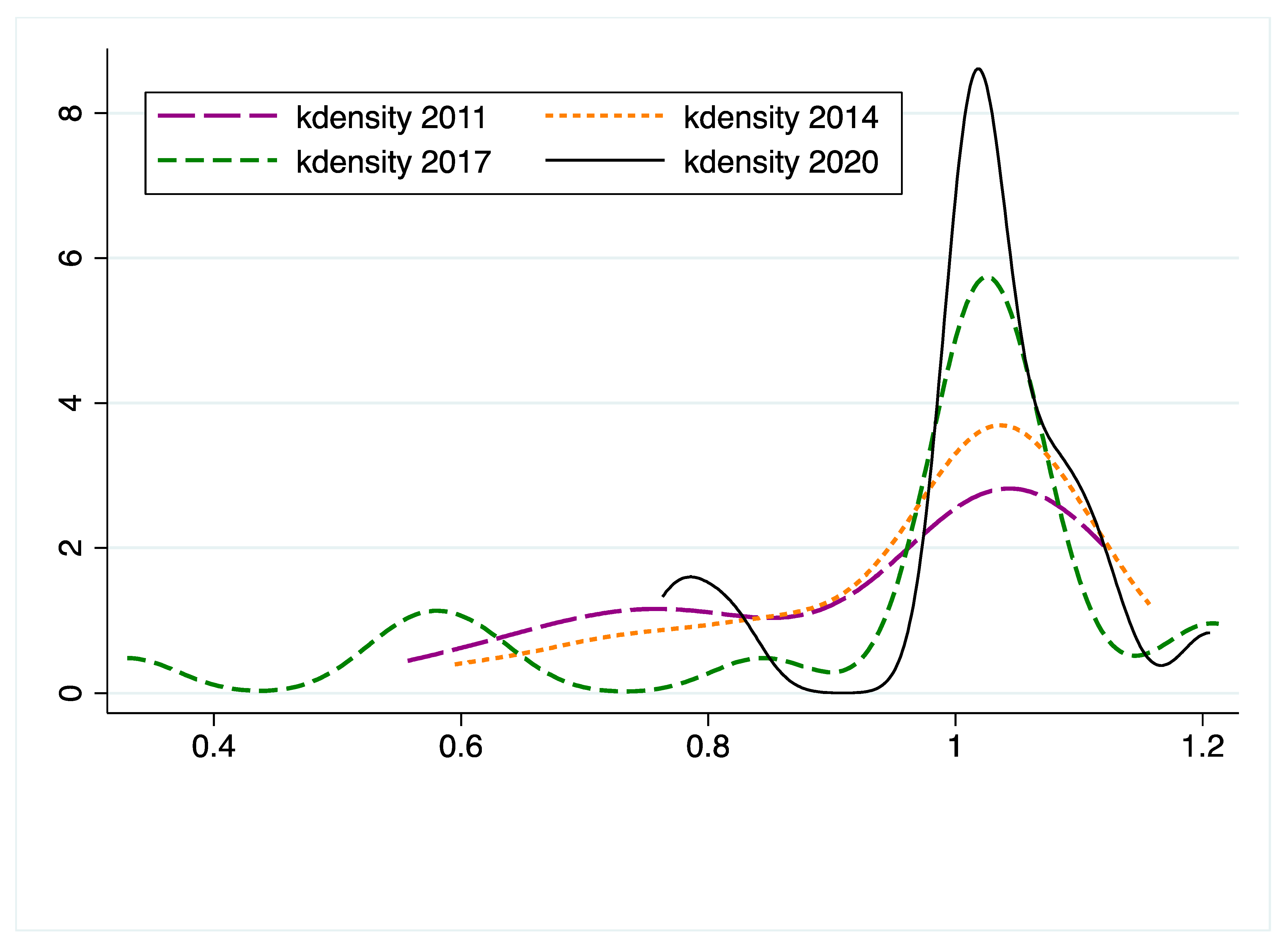
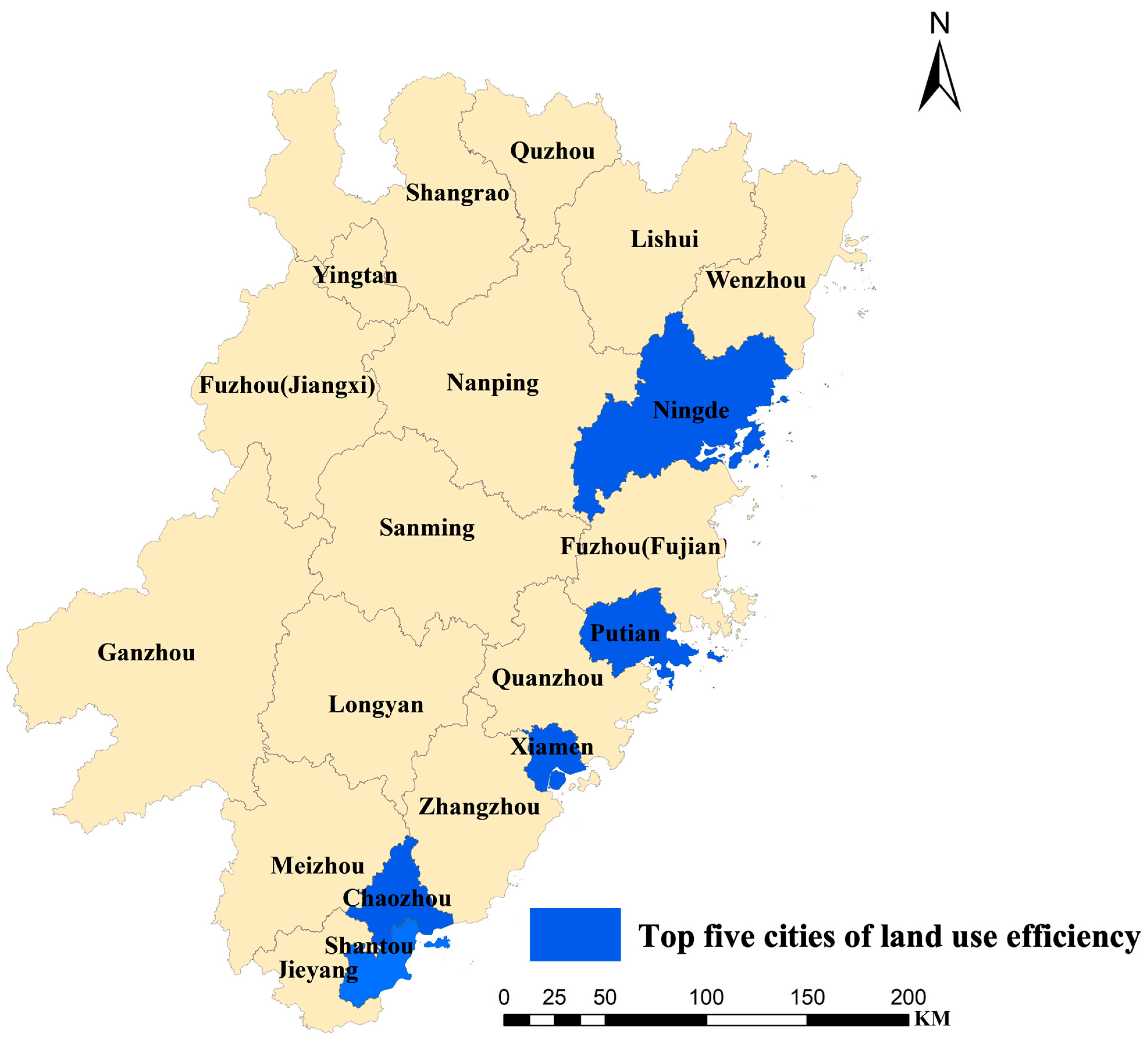
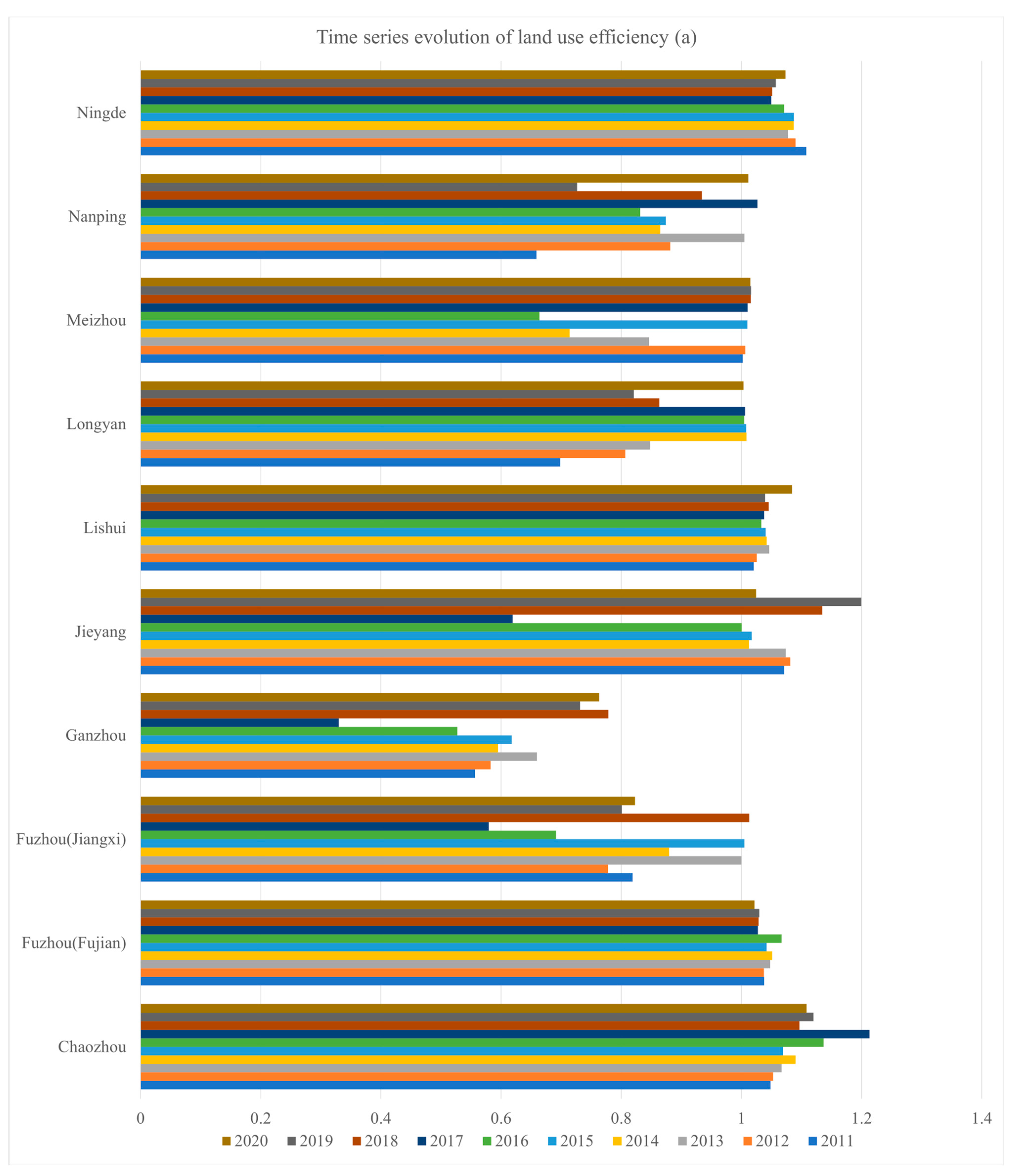
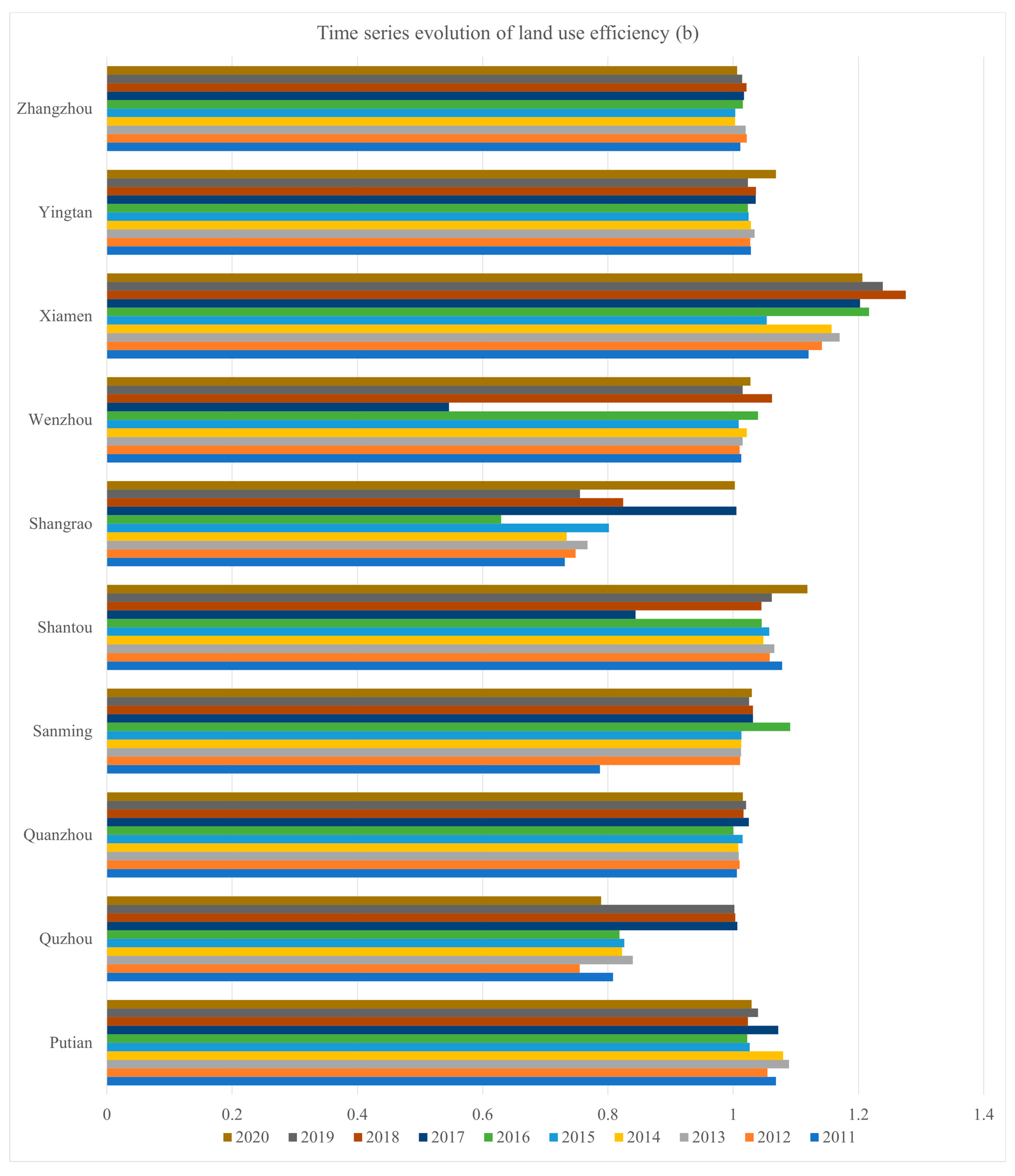
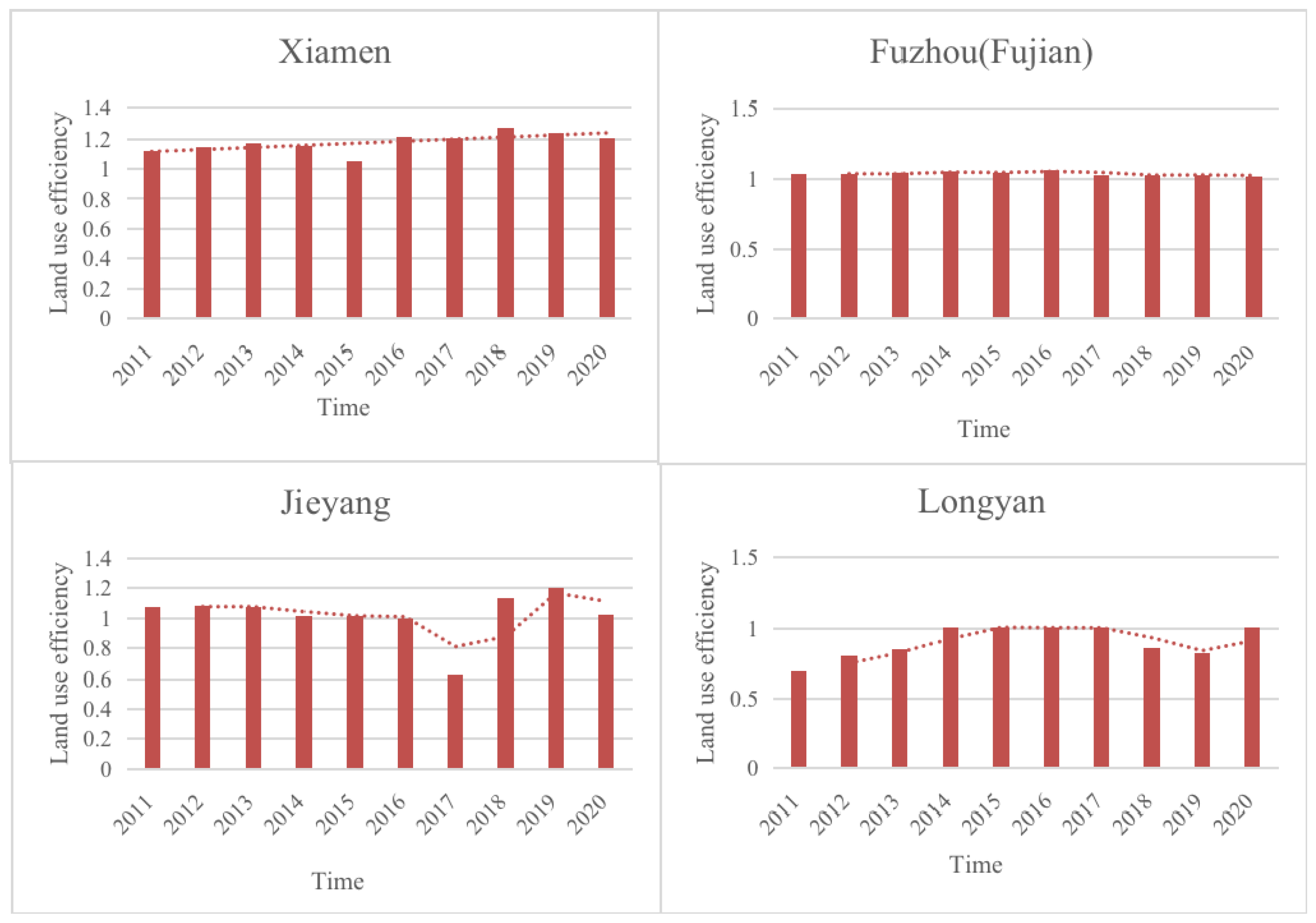
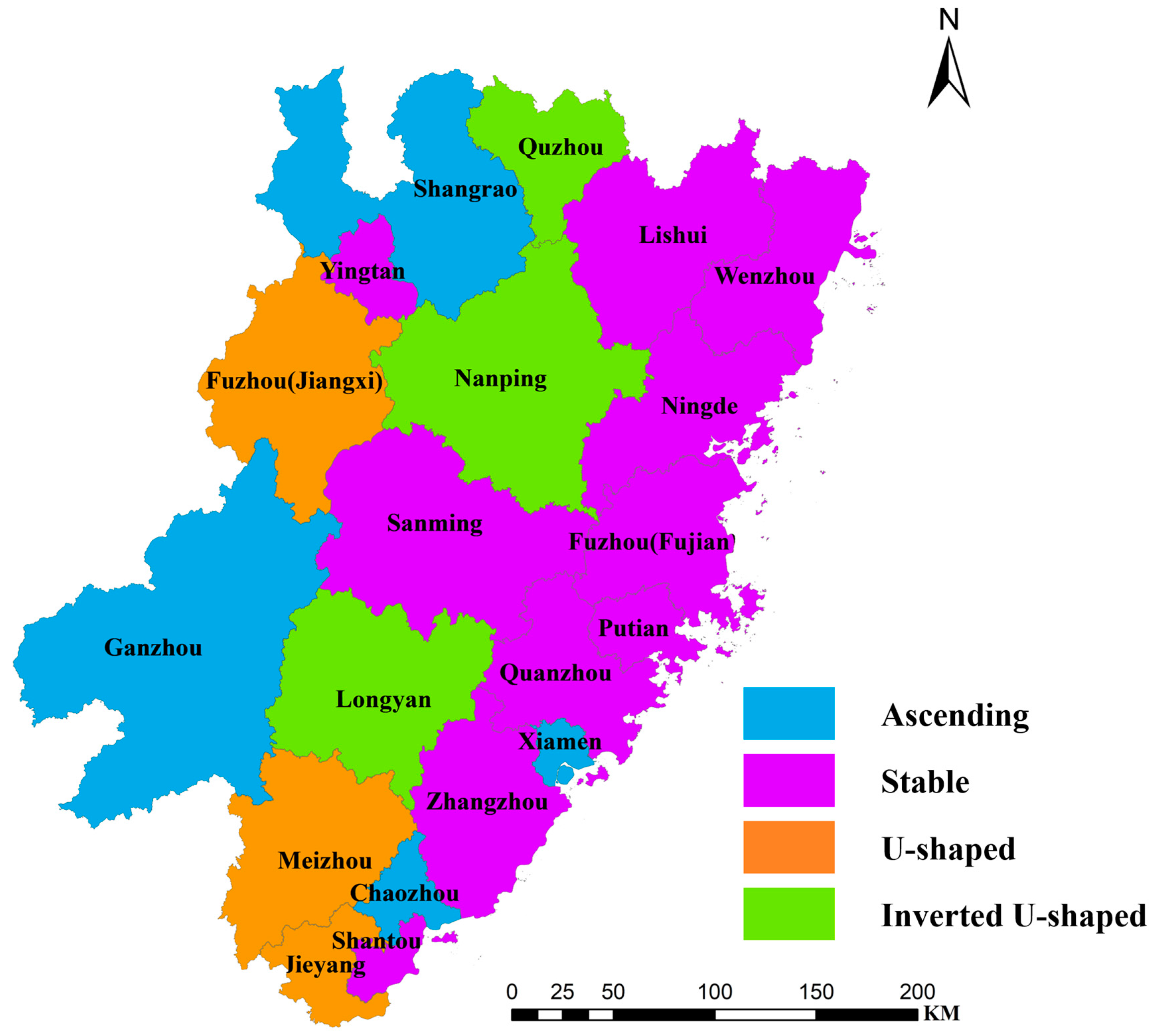
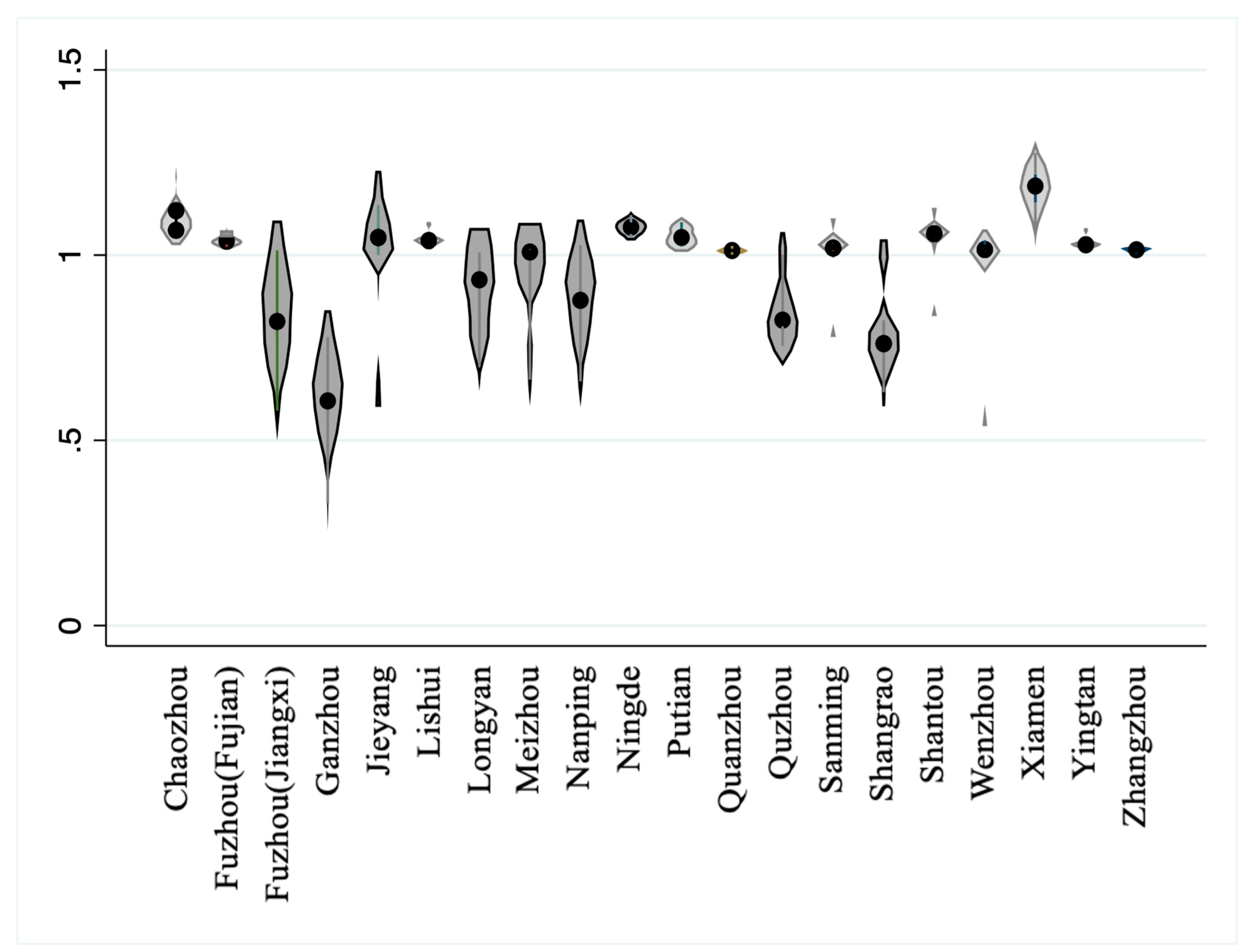


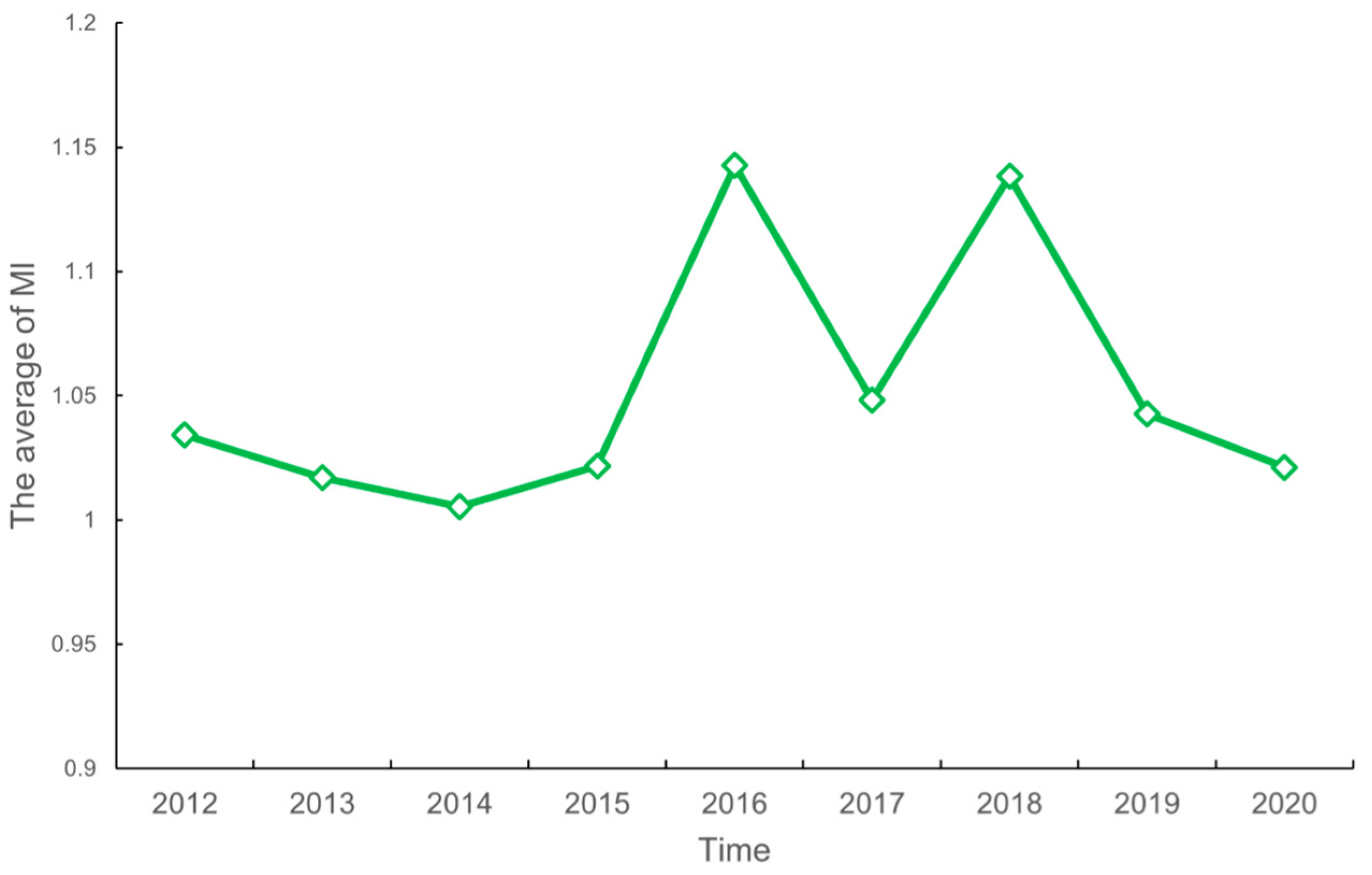
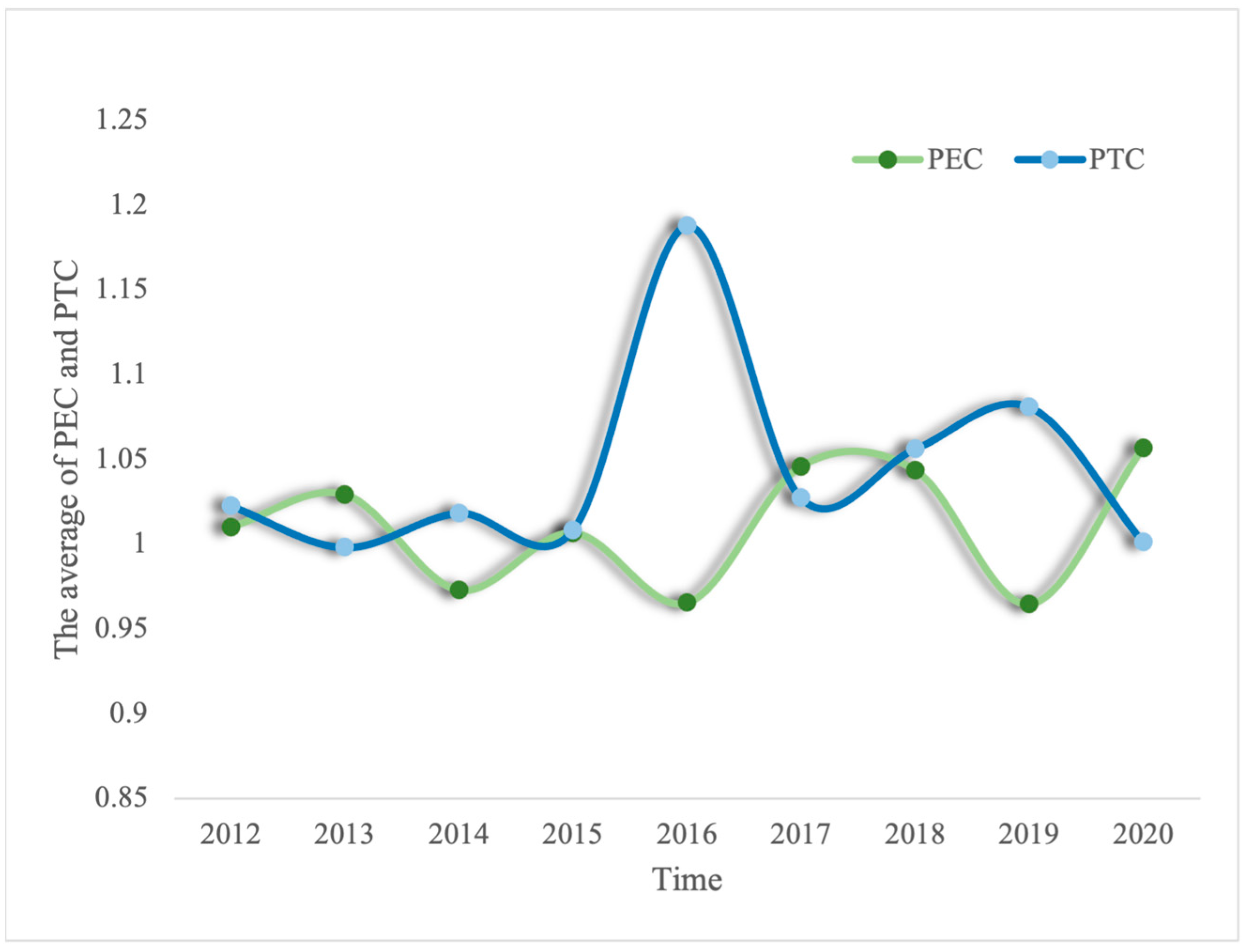
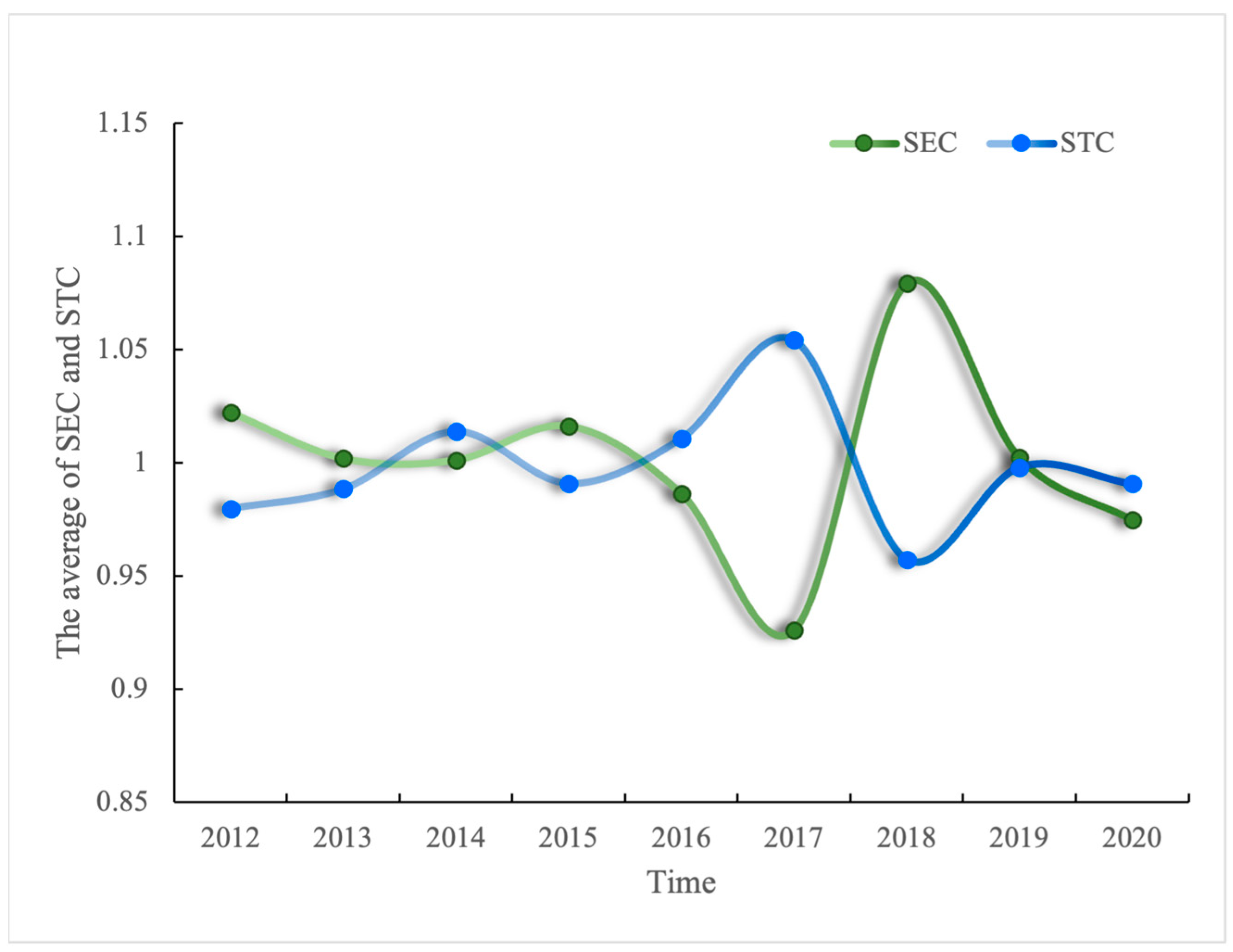
| Serial Number | Region | Province |
|---|---|---|
| 1 | Chaozhou | Guangdong |
| 2 | Fuzhou (Fujian) | Fujian |
| 3 | Fuzhou (Jiangxi) | Jiangxi |
| 4 | Ganzhou | Jiangxi |
| 5 | Jieyang | Guangdong |
| 6 | Lishui | Zhejiang |
| 7 | Longyan | Fujian |
| 8 | Meizhou | Guangdong |
| 9 | Nanping | Fujian |
| 10 | Ningde | Fujian |
| 11 | Putian | Fujian |
| 12 | Quzhou | Zhejiang |
| 13 | Quanzhou | Fujian |
| 14 | Sanming | Fujian |
| 15 | Shantou | Guangdong |
| 16 | Shangrao | Jiangxi |
| 17 | Wenzhou | Zhejiang |
| 18 | Xiamen | Fujian |
| 19 | Yingtan | Jiangxi |
| 20 | Zhangzhou | Fujian |
| Criterion Level | Element Level | Index Level | Unit |
|---|---|---|---|
| Input index | Fund | Total fixed assets investment | 100 million yuan |
| Labor | Number of employees in the secondary and tertiary industries | People | |
| Ground | Construction area | Square kilometer (sq.km.) | |
| Expected output index | Economic benefit | Output value of the secondary and tertiary industries | 100 million yuan |
| Social benefit | The average salary of urban employees | Yuan | |
| Environment benefit | Area of park green areas | Hectare | |
| Undesired output index | Negative impact on the environment (three industrial wastes) | Industrial wastewater discharged | 10,000 tons (10,000 t) |
| Industrial waste gas (SO2) emissions | Ton (t) | ||
| Industrial smoke (powder) dust production | Ton (t) |
Disclaimer/Publisher’s Note: The statements, opinions and data contained in all publications are solely those of the individual author(s) and contributor(s) and not of MDPI and/or the editor(s). MDPI and/or the editor(s) disclaim responsibility for any injury to people or property resulting from any ideas, methods, instructions or products referred to in the content. |
© 2024 by the authors. Licensee MDPI, Basel, Switzerland. This article is an open access article distributed under the terms and conditions of the Creative Commons Attribution (CC BY) license (https://creativecommons.org/licenses/by/4.0/).
Share and Cite
Xu, H.; Zhang, R. Dynamic Analysis of Urban Land Use Efficiency in the Western Taiwan Strait Economic Zone. Land 2024, 13, 1298. https://doi.org/10.3390/land13081298
Xu H, Zhang R. Dynamic Analysis of Urban Land Use Efficiency in the Western Taiwan Strait Economic Zone. Land. 2024; 13(8):1298. https://doi.org/10.3390/land13081298
Chicago/Turabian StyleXu, Haixiang, and Rui Zhang. 2024. "Dynamic Analysis of Urban Land Use Efficiency in the Western Taiwan Strait Economic Zone" Land 13, no. 8: 1298. https://doi.org/10.3390/land13081298





